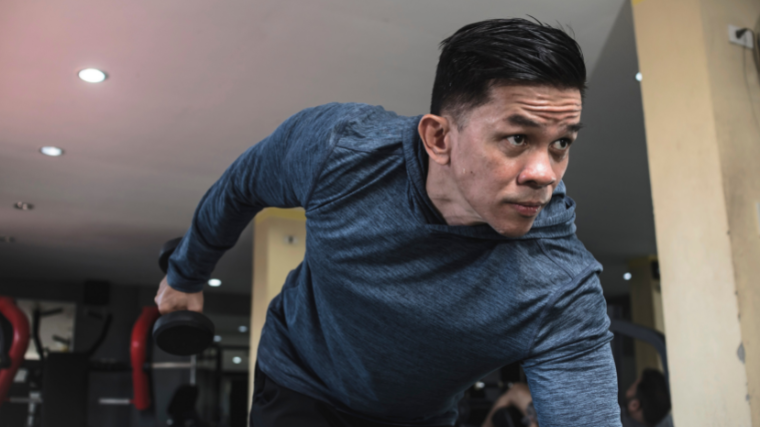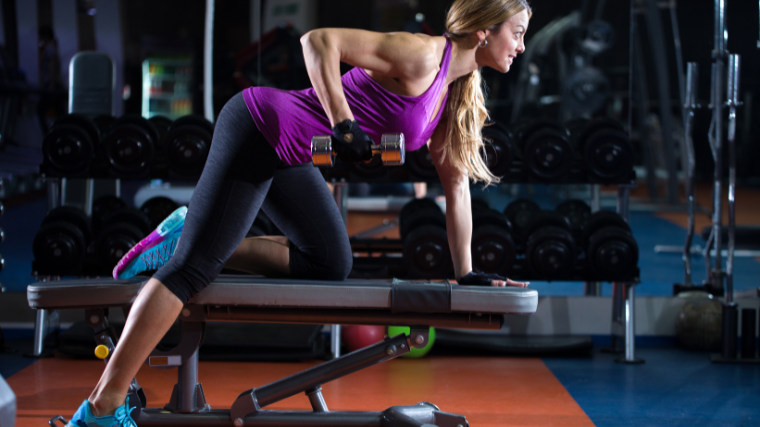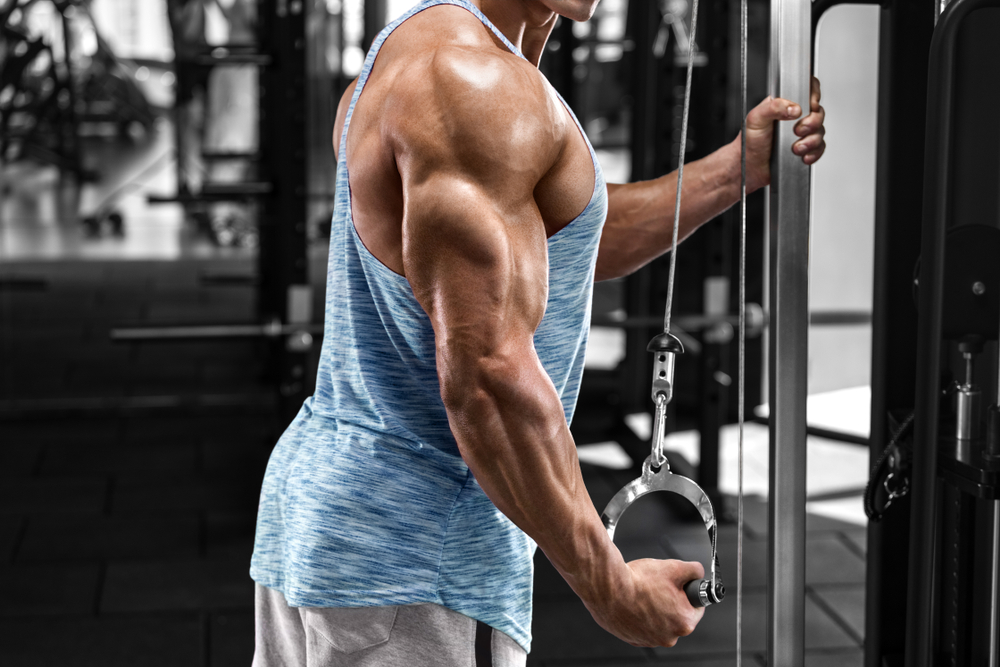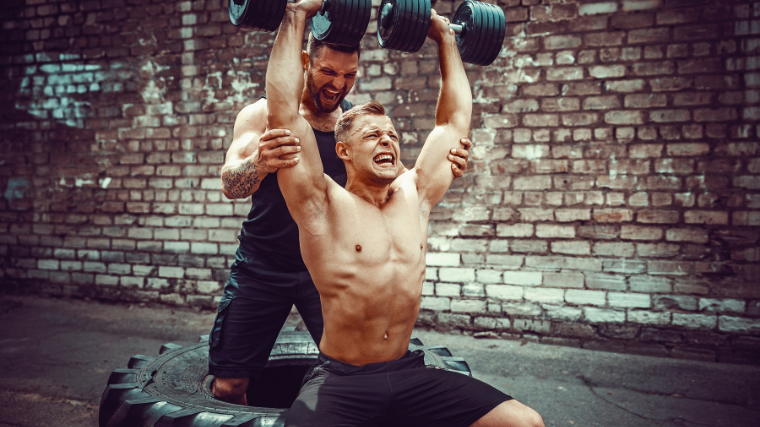Your bench press has stalled, and your overhead press just won’t lock out — no matter how much you try. When you reach a certain level in your training, chest and shoulder strength just aren’t going to cut it. That last portion of your presses requires strong triceps to convert a strong start into a powerful, locked-out finish.

This is where the triceps kickback comes to the rescue. It seems like a lowly lift because you won’t be moving a lot of weight around. But don’t be deceived — you don’t always need to heft heavy loads to have a hefty impact on your training. Read on to find out how to do the triceps kickback, and how it can help you bust through plateaus and build those thick upper arms.
- How to Do Triceps Kickback
- Triceps Kickback Sets and Reps
- Common Triceps Kickback Mistakes
- Triceps Kickback Variations
- Triceps Kickback Alternatives
- Muscles Worked by the Triceps Kickback
- Benefits of the Triceps Kickback
- Who Should Do the Triceps Kickback
- Frequently Asked Questions
How to Do the Triceps Kickback
Especially when you’ll be lifting such a light weight, it’s tempting to let momentum take over and neglect your form. But to get the most out of this move, pay close attention to moving with deliberate form.
Step 1 — Set Up
Stand alongside a weight bench. Hinge forward with a light weight in one hand until you’re roughly parallel to the ground. Brace your free hand on the weight bench, maintaining a strong hip hinge. Row the weight back so that you’re upper arm is in line with your ribcage.
Coach’s Tip: You can opt to put your opposite knee on the bench for added balance and stability instead of maintaining a more unsupported hinge.
Step 2 — Kick Back
Slowly extend your arm until it’s locked out behind you. Squeeze your triceps — hard — for a second in the fully extended position. Make sure your upper arm has not moved. The only movement should be coming from your elbow, with your forearm doing the actual moving.
Coach’s Tip: You can keep the pinky side of your hand neutral in the top position so that it’s facing the ceiling. Alternatively, you can twist your hand (keep your wrist neutral) so that your palm is facing the ceiling instead.
Step 3 — Return to Starting Position
With control, lower the weight back to starting position. Do not move your upper arm. Take a moment to establish control with your arm bent at 90 degrees, then slowly start your next rep.
Coach’s Tip: Place a great amount of mental and physical focus on keeping your upper arm in an isometric — non-moving — position. If the weight is consistently yanking your arm out of position, you’re probably using something too heavy.
Triceps Kickback Sets and Reps
This is not one that you’re going to use for maximal strength-building, but you can (and should) have a general goal with your accessory moves. Use these set and rep schemes as a guide for your triceps kickback programming.
- For Muscle Mass: Do three sets of 12 to 15 reps, emphasizing a strong squeeze at the top and moving slowly with the eccentric (lowering) phase.
- For Strength: Perform three sets of eight to 12 reps with heavier weight.
- For Endurance: Opt for three to four sets of 15 to 25 reps, making sure not to swing the weight.
Especially when you’re working toward building strength, find a weight that makes it very challenging to keep your upper arm steady. That said, it shouldn’t be heavy enough to yank your upper arm out of place. Make sure you can maintain a solid isometric contraction there.
Common Triceps Kickback Mistakes
It’s all too easy to neglect proper form when you’re working with generally light weights. Avoid these triceps kickback mistakes to maximize your gains.
Using Too Much Weight
Select a weight that challenges you, but not one that will compromise your form. You’ll often see lifters needing to yank their upper arms back into position or needing to twist their body completely to toss the weight back behind them.
While a little bit of body English and cheating with your form can be helpful for advanced athletes with generally solid form, you don’t want to start your sets that way. Instead, select a weight that challenges you to keep your upper arm in an isometric position without compromising your ability to control your elbow extension.
Not Squeezing at the Top
Squeezing your triceps at the top of each rep is going to be one of your biggest allies with this move. Getting that full muscle contraction will help maximize the muscle-building potential of this movement. Take a full second to squeeze your triceps — hard — once your elbow fully extends.
Using Momentum
The close cousin of not squeezing your triceps at the top of this move is swinging your weight with momentum. The strength- and muscle-building key with moves like this is time under tension. Don’t cheat yourself out of those benefits by tossing the weight up with momentum rather than a disciplined, slow movement.
Take a solid exhale with each extension of your elbow. Your aim will be to keep the weight steady while also ensuring that you can reach full lockout — especially at the beginning of your sets — without yanking your body or the weight.
Triceps Kickback Variations
There’s more than one way to kick back your triceps. If you’re bored of regular kickbacks or just want to try a slightly different training stimulus, try these triceps kickback variations on for size.
Cable Triceps Kickback
You’ll be moving through the same exact motion here as you do with dumbbells. But instead of a free weight in your hand, you’ll be using a cable machine to help you get to your goals. The cable will provide accommodating resistance, maximizing your time under maximum tension for even bigger muscle-building potential.
While you might opt to use a D-handle, you might find it a lot more comfortable to keep the end of the cable bare, with just the carabiner attached. This can help you maximize your focus on fully squeezing your triceps at the end of each rep.
Two-Handed Triceps Kickback
Instead of bracing a non-working hand on a bench or weight rack, this variation will have you with a weight in both hands. This way, you’ll be holding an isometric hip hinge completely unsupported as both of your arms work to kick back.
This variation allows you to really hone in on your balance, core strength, and hamstring flexibility while training your triceps. So if you’re trying to give yourself more of a full-body effect, this allows you to engage your full body to some degree in an isolation exercise.
Reverse Grip Triceps Kickback
While many athletes opt to rotate their palm up to face the ceiling at the end of the kickback, it’s also an option to perform this lift with a reverse grip the whole time. Instead of starting the kickback with your hand in a neutral hammer grip, start your set-up with your palm already facing up.
This will provide your triceps with a slightly different training stimulus, allowing you to alter your exercise angle slightly. Some lifters may also find this variation easier on their elbow joints.
Triceps Kickback Alternatives
Maybe your last training cycle was all about triceps kickbacks and you’re looking for a new triceps accessory. But if you loathe letting go of the benefits of kickbacks, rest assured that these alternatives will also keep your triceps plenty big and strong.
Overhead Triceps Extension
This classic triceps move requires a cable machine, a triceps rope, and a whole lot of discipline. You’ll set the cable anchor at a low position and face away from the machine, working to bring the triceps rope up and overhead.
Just like with the triceps kickback, work hard to keep your upper arms steady and in the same place throughout this lift. While holding that isometric, let the weight from the cable start pulling your arms down slightly at the bottom of each lift. This will maximize muscle engagement — and your gains.
Triceps Pushdown
With a similar payoff as the kickback, the triceps pushdown lets you really hone in on that contraction and extension. Instead of standing in a hinged position with the weight extending out behind you, you’ll be standing upright and pushing the weights down and to the sides.
As you do with the triceps kickback, be sure to squeeze your triceps when your arms reach full extension. Doing so will likely reduce the amount of weight you can use, but it will also increase your mind-muscle connection and help you get stronger in the process.
Skull Crusher
Finally, you get to lie down. But skull crushers don’t signify break time. You’ll use an EZ-bar, barbell, or dumbbells to help you give your triceps a tough, hypertrophy-inducing set.
The theme with all of these alternatives is the fight to keep your upper arms steady. You can load skull crushers fairly heavily if your elbows allow it, but make sure you’re maintaining the integrity of your upper arm isometric throughout.
Muscles Worked by the Triceps Kickback
Your back will be involved in keeping your upper body stable during the move, which is significant. That said, your back shouldn’t be involved in the actual movement portion of the lift.
Triceps
As an isolation movement, this one is all about your triceps. Your triceps has three heads — the long, lateral, and medial heads. Many triceps isolation exercises seek to emphasize the long head, which is a crucial part of developing thick upper arms.
[Read More: Our Favorite Forearm Workouts, + the Best Forearm Exercises]
The triceps kickback, however, favors the lateral and medial heads of your triceps. This is tremendously helpful for developing well-rounded muscles that can really help with your lockout strength since these are the heads emphasized in pressing.
Benefits of the Triceps Kickback
The triceps kickback might not look like the toughest kid on the triceps block, but it comes with a whole host of benefits.
Bigger Triceps
This triceps move has a lot going for it in terms of helping you get those sleeve-ripping upper arms. Firstly, it’s a triceps isolation movement, which helps add muscle-building volume to your routine without overtaxing the surrounding muscles (think: your shoulders and chest).
Secondly, the triceps kickback requires you to use lighter weights but really focus on your time under tension. Spending a lot of time with your muscle going through mechanical strain is a great way to promote hypertrophy. Overall, that’s a solid recipe for solid muscle mass.
Bust Through Pressing Plateaus
Sure, bench presses are about your chest and overhead presses are about your shoulders. But without a robust set of triceps, all the chest or shoulder strength in the world won’t help you keep progressing after a certain point.
With presses, the last third or so of the lift is pretty much all about your triceps. Simply put, you need strong triceps to lock out those big lifts.
The triceps kickback helps you target your triceps for growth and strength without adding extra stress to your chest and shoulders. This valuable isolation volume lets you give your triceps the extra attention they need to avoid becoming the weakest link in your presses.
Smaller Range of Motion
A lot of your triceps training likely revolves around longer ranges of motion that focus on the long head of your triceps. That’s with good reason.
But the triceps kickback will take you through a smaller range of motion, allowing you to focus on your peak contraction. Because you’ll be using lighter weight and taking it through a small range, this move might also be easier on your elbows.
Who Should Do the Triceps Kickback
The triceps kickback might be a staple in beginners’ routines, but you might be tempted to abandon it as you gain more experience. It’s humbling to pick up such a light weight, especially if you’ve been around the block a bit. But even advanced athletes can benefit from this move.
Physique Athletes
With the triceps kickback, you can tack on high-quality volume without fatiguing related muscle groups. Since this move is unilateral, you’ll also be able to focus on ironing out any asymmetries you might have. If it’s sleeve-popping arms you’re chasing — whether you’re a beginner or an experienced lifter — the triceps kickback can come in handy.
Strength Athletes
Strength athletes need elite lockout strength. Your presses are bound to stall if your triceps can’t keep up with the load you’re trying to press. By giving special attention to your triceps, you’ll be developing that final push that every press requires to be completed to lockout.
Athletes on the Go
If you’re working out in a hotel, you’ve likely got a limited amount of weight available to you. Take advantage of being surrounded by lighter weights and opt for lifts that don’t require a lot. Triceps kickbacks will help give you that on-the-go pump you’re chasing without demanding that you break out the big dumbbells.
Kick it Back
When you’ve hit a plateau with your presses, it’s often time to turn to your triceps. Are they strong enough to take your bench and overhead pressing to the next level? If the answer is no, it might be time to work harder by kicking it back. The triceps kickback might not have you lifting a lot of weight at the moment, but boosting your triceps strength is sure to help you heft heavier loads when it’s time to press.
FAQs
You might still have questions about how to maximize your triceps training with the kickback. That’s cool. We still have answers.
How do you do triceps kickbacks?
This move looks simple, but you’ll want to move with slow deliberation the whole time. By hinging at your hips and possibly recruiting support from a bench or weight rack, you can maximize focus on your triceps.
Keep your upper arm locked into place while extending your arm all the way back behind you to lockout. Squeeze at the top and slowly bend your elbow to come back to the starting position. Your upper arm can work hard to keep itself in place, but it shouldn’t really be moving.
What weight should you use for triceps kickbacks?
You don’t generally want to move a lot of weight with the triceps kickback. If the weight is pulling your upper arm down, it’s probably too heavy for this move.
That said, make sure you don’t swing all the way in the opposite direction. Yes, you want to be using a light weight, but experiment until you find one that is both light and challenges you during this movement.
If it’s tricky to find a suitable weight or your gym doesn’t have the precisely correct weight available, use one weight increment down from what you think you need. Then, use a high rep scheme and emphasize slow eccentric movement with an especially strong squeeze at the top of each rep.
Are triceps kickbacks good for muscle growth?
Your triceps play a huge role in the pressing movements that probably make up a solid portion of your upper body training. But because the primary muscles being worked during big presses are your chest or shoulders, the triceps don’t necessarily get a lot of opportunities for growth with those moves after a certain point.
For that reason, isolating your triceps is a great way to promote triceps muscle growth. Especially when you’re a more advanced lifter, isolation exercises can help devote specific attention to any lagging muscles while giving your bigger muscles the breaks they need to come back stronger in your next session.
Featured Image: lunamarina / Shutterstock





